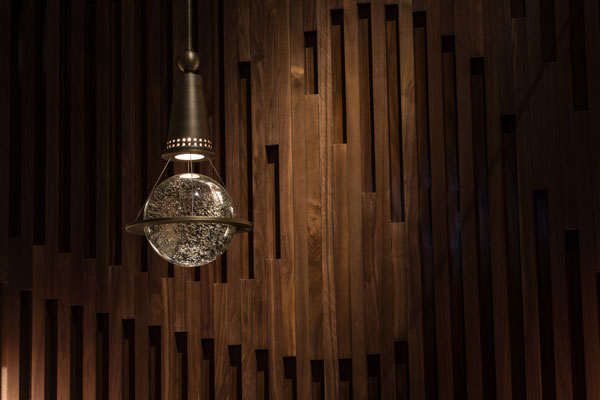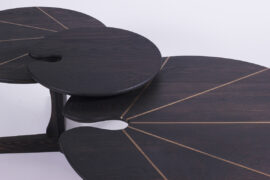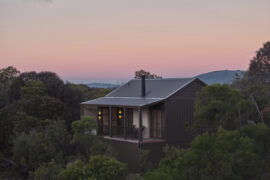David Collins Studio has designed the interior of a restaurant that exerts a special presence in Hong Kong with hints of continental European cafés. Samantha Seet has the story.

April 8th, 2015
Images: Courtesy of David Collins Studio
While many interiors proudly express autonomy from the architecture that encloses them, in some circumstances, the reverse is an essential tactic that shows the hallmark of an evolved and honed approached to hospitality. An ideal example is The Continental – a restaurant (formerly Domani) within a freestanding building designed by Thomas Heatherwick at Pacific Place.
“We were invited to reconsider the space and its relationship with the original structure and ceiling details,” says Simon Rawlings, Creative Director of David Collins Studio – the UK-based studio that designed the interior. He continues, “The brief was to revise the layout by expanding the restaurant area to accommodate up to 120 guests, while creating a dramatic bar at the entrance. We subtly re-imagined the experience to offer a unique bar and dining experience.” Additionally, he says, an in-house patisserie feature adds a sense of theatre, with references to the grand cafés of Europe.
In all of David Collins Studio’s projects, says Rawlings, a sense of belonging is important. The design must fit with its location and surroundings. At The Continental, he explains, one of the key challenges faced was the imposing geometry and sculptural quality of the existing building. “The team saw it as an opportunity to honour and respect the modernity and spirit of the architecture with an interior that could complement and contrast at the same time,” he says. In consideration of the building’s undulating curves, a ribbon-like timber mural was created on the walls. Conversely, a sense of uniformity was instilled in the layout to achieve maximum efficiency within the space.
From the point of arrival, The Continental captures attention with a sense of warmth and sophistication. The bar area features a reception space and intimate table groupings. Rawlings is happy to share that opening up the length of the restaurant is perhaps “the cleverest thing done” because a surprising level of transparency was created that enables everyone a bucolic view and experience of the dining room.
Taking advantage of the building’s curves, a wraparound leather banquette hugs the furthest corner, highlighting the expansive windows yet providing an intimate retreat for small groups. Private booths line either side, with those along the inner wall incorporating taller dividing partitions that offer enhanced privacy. Otherwise, the design allows for an uninterrupted flow of space, ensuring the seamless operation of the various functions of the restaurant.
To create depth in the design, layers of luxurious materials in shades of green were applied. Rawlings explains, “We wanted to give The Continental a subtle sense of place by referring to the greenery of The Peak in its overall colour scheme. At the same time, the emerald-coloured upholstery and hand-glazed Italian ceramic tiles bring the surrounding outdoor green into the bar and restaurant.”

Resonating with the design studio’s characteristically personalised sense of style, The Continental features custom-designed leather-upholstered furniture. Throughout the space, white marble contrasts with the vibrant glazed ceramics, textured oak panels and bronze detailing. Hanging from cleverly positioned rails within the existing undulating ceiling, the bespoke customised glass pendants with brass trimmings lend an ethereal feel to the space. The resultant effect is a light-filled oasis by day and a sumptuous, relaxed space by night.
Rawlings explains, “Lighting is a key design focus throughout all of our designs. Along with our use of colour, it’s what we are renowned for. With The Continental being open to guests from day to night, we wanted to use lighting to complement the desired mood – one that could be carried throughout these sittings. [The interior is] naturally lit by day and enjoys a relaxed, warm atmosphere into evening.”
The restaurant enjoys a strong sense of authenticity that is timeless and avoids being read as age or demographic specific. I catch myself nodding in agreement when Rawlings shares: “I love the contemporary and playful spirit that is carried through the design and reflected in the styling, choice of accessories, colours and textures. The space is complementary yet contrasting and it is this element that I find most intriguing.”
This article first appeared in Cubes Indesign issue 72.
DAVID COLLINS STUDIO
davidcollins.com
INDESIGN is on instagram
Follow @indesignlive
A searchable and comprehensive guide for specifying leading products and their suppliers
Keep up to date with the latest and greatest from our industry BFF's!

Gaggenau’s understated appliance fuses a carefully calibrated aesthetic of deliberate subtraction with an intuitive dynamism of culinary fluidity, unveiling a delightfully unrestricted spectrum of high-performing creativity.

A longstanding partnership turns a historic city into a hub for emerging talent

For Aidan Mawhinney, the secret ingredient to Living Edge’s success “comes down to people, product and place.” As the brand celebrates a significant 25-year milestone, it’s that commitment to authentic, sustainable design – and the people behind it all – that continues to anchor its legacy.
The internet never sleeps! Here's the stuff you might have missed

The second installment in our three-part series on collaborations between the world’s best designers and the American Hardwood Export Council

In what is already a peaceful idyll on the Mornington Peninsula, Kate Walker has crafted an intimate retreat with new villas for overnight stays at Alba.